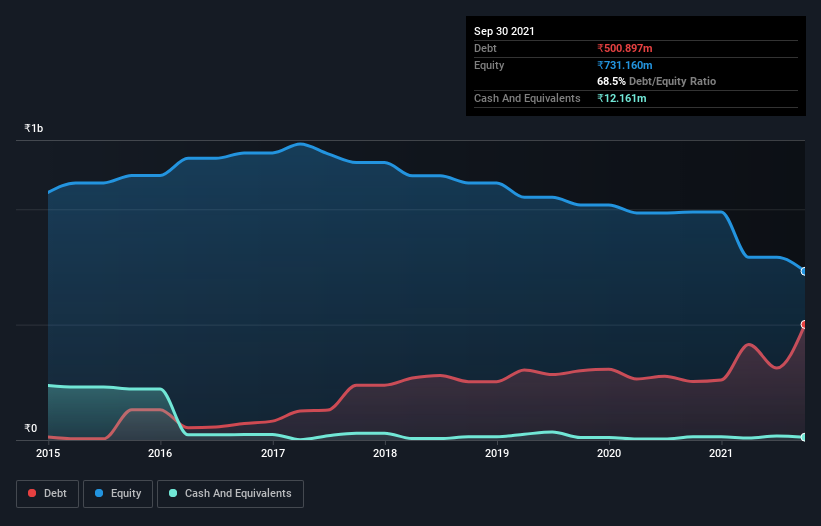Legendary fund manager Li Lu (who Charlie Munger backed) once said, 'The biggest investment risk is not the volatility of prices, but whether you will suffer a permanent loss of capital.' So it might be obvious that you need to consider debt, when you think about how risky any given stock is, because too much debt can sink a company. Importantly, Brooks Laboratories Limited (NSE:BROOKS) does carry debt. But the more important question is: how much risk is that debt creating?
Why Does Debt Bring Risk?
Debt is a tool to help businesses grow, but if a business is incapable of paying off its lenders, then it exists at their mercy. If things get really bad, the lenders can take control of the business. However, a more frequent (but still costly) occurrence is where a company must issue shares at bargain-basement prices, permanently diluting shareholders, just to shore up its balance sheet. Of course, debt can be an important tool in businesses, particularly capital heavy businesses. The first thing to do when considering how much debt a business uses is to look at its cash and debt together.
Check out our latest analysis for Brooks Laboratories
What Is Brooks Laboratories's Debt?
As you can see below, at the end of September 2021, Brooks Laboratories had ₹500.9m of debt, up from ₹253.7m a year ago. Click the image for more detail. On the flip side, it has ₹12.2m in cash leading to net debt of about ₹488.7m.

How Strong Is Brooks Laboratories' Balance Sheet?
We can see from the most recent balance sheet that Brooks Laboratories had liabilities of ₹860.1m falling due within a year, and liabilities of ₹155.0m due beyond that. On the other hand, it had cash of ₹12.2m and ₹166.4m worth of receivables due within a year. So its liabilities outweigh the sum of its cash and (near-term) receivables by ₹836.5m.
While this might seem like a lot, it is not so bad since Brooks Laboratories has a market capitalization of ₹3.00b, and so it could probably strengthen its balance sheet by raising capital if it needed to. However, it is still worthwhile taking a close look at its ability to pay off debt. There's no doubt that we learn most about debt from the balance sheet. But you can't view debt in total isolation; since Brooks Laboratories will need earnings to service that debt. So if you're keen to discover more about its earnings, it might be worth checking out this graph of its long term earnings trend.
Over 12 months, Brooks Laboratories saw its revenue hold pretty steady, and it did not report positive earnings before interest and tax. While that hardly impresses, its not too bad either.
Caveat Emptor
Importantly, Brooks Laboratories had an earnings before interest and tax (EBIT) loss over the last year. To be specific the EBIT loss came in at ₹153m. Considering that alongside the liabilities mentioned above does not give us much confidence that company should be using so much debt. Quite frankly we think the balance sheet is far from match-fit, although it could be improved with time. However, it doesn't help that it burned through ₹32m of cash over the last year. So suffice it to say we do consider the stock to be risky. There's no doubt that we learn most about debt from the balance sheet. However, not all investment risk resides within the balance sheet - far from it. For example Brooks Laboratories has 3 warning signs (and 1 which is a bit concerning) we think you should know about.
When all is said and done, sometimes its easier to focus on companies that don't even need debt. Readers can access a list of growth stocks with zero net debt 100% free, right now.
Valuation is complex, but we're here to simplify it.
Discover if Brooks Laboratories might be undervalued or overvalued with our detailed analysis, featuring fair value estimates, potential risks, dividends, insider trades, and its financial condition.
Access Free AnalysisHave feedback on this article? Concerned about the content? Get in touch with us directly. Alternatively, email editorial-team (at) simplywallst.com.
This article by Simply Wall St is general in nature. We provide commentary based on historical data and analyst forecasts only using an unbiased methodology and our articles are not intended to be financial advice. It does not constitute a recommendation to buy or sell any stock, and does not take account of your objectives, or your financial situation. We aim to bring you long-term focused analysis driven by fundamental data. Note that our analysis may not factor in the latest price-sensitive company announcements or qualitative material. Simply Wall St has no position in any stocks mentioned.
About NSEI:BROOKS
Brooks Laboratories
Manufactures and sells pharmaceuticals in India and internationally.
Flawless balance sheet with acceptable track record.
Market Insights
Community Narratives



